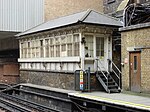Kindertransport – The Arrival
2006 establishments in the United Kingdom2006 sculpturesBronze sculptures in the United KingdomKindertransportLondon stubs ... and 4 more
Monuments and memorials in LondonOutdoor sculptures in LondonStatues in LondonUnited Kingdom sculpture stubs

Kindertransport – The Arrival is an outdoor bronze memorial sculpture by Frank Meisler, located in the forecourt of Liverpool Street station in London, United Kingdom. It commemorates the 10,000 orphaned Jewish children who escaped Nazi persecution and arrived at the station during 1938–1939. The memorial was installed in September 2006, replacing Flor Kent's bronze Für Das Kind (For the Child), which was installed in 2003. It was commissioned by World Jewish Relief and the Association of Jewish Refugees (AJR).
Excerpt from the Wikipedia article Kindertransport – The Arrival (License: CC BY-SA 3.0, Authors, Images).Kindertransport – The Arrival
Hope Square, City of London
Geographical coordinates (GPS) Address External links Nearby Places Show on map
Geographical coordinates (GPS)
| Latitude | Longitude |
|---|---|
| N 51.517586 ° | E -0.082563 ° |
Address
Kindertransport – The Arrival
Hope Square
EC2M 7PR City of London
England, United Kingdom
Open on Google Maps











